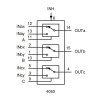Hey all I am trying to find an IC that can accommodate having 2 inputs but only one output depending on what I send via a PIC18fxxxx micro controller. This sounds like it would be a DPST but I can't really find anything like that I can control from a PIC to choose what output needs to be on.
The 5vdc and 12vdc will be to power a PC FAN. The 5 and 12vdc will be coming from the PC PSU.
A 12vdc fan is around 0.25A ~4W
A 5vdc fan is around 0.18A ~2W
So something like so:
Or better visually is this:

The PIC pin would control the IC to let it know which voltage to output.
Does anyone know if this type of IC exists? I'll need to be able to do 10 outputs all together.
The 5vdc and 12vdc will be to power a PC FAN. The 5 and 12vdc will be coming from the PC PSU.
A 12vdc fan is around 0.25A ~4W
A 5vdc fan is around 0.18A ~2W
So something like so:
Code:
|------|
---5vdc-in----->| IC |
---12vdc-in---->| ? |-----5 or 12vdc-out-->
---PIC pin-in-->| |
|------|
The PIC pin would control the IC to let it know which voltage to output.
Does anyone know if this type of IC exists? I'll need to be able to do 10 outputs all together.



